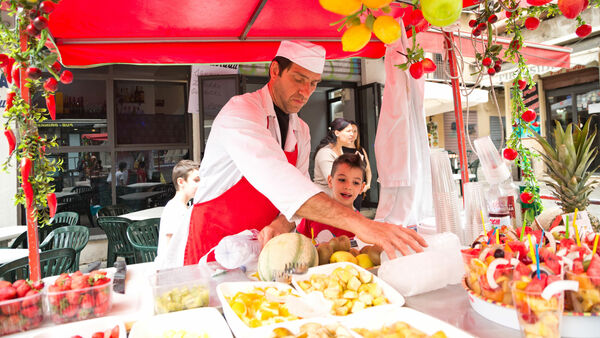Recipe: Granita (Italian Icy, Slushy Treat)

Gelato’s icy cousin, granita, is sweet fruit juice, nut milk, or coffee that has been gently frozen to a slushy consistency. Traditional flavors are mandorla (almond), limone (lemon), and gelsi (mulberry), but you’ll find many others. Granita di caffè is a very refreshing way to consume your coffee. When topped with whipped cream (con panna), it’s a luxurious frozen latte.
In the hot summer months, many Sicilians opt for granita at breakfast time. They might get a strong espresso accompanied by a glass of granita di mandorla and a sweet, warm brioche — which they dip into the granita, like a scoop.
Here are two granita recipes, one for coffee and the other for lemon.
Ingredients for 4-6 Servings of Granita di Caffè:
1 cup (225 milliliters) cold water
½ cup (115 grams) granulated sugar
2 cups (450 milliliters) freshly brewed espresso
Freshly whipped cream
Ingredients for 4-6 Servings of Granita di Limone:
2 cups (450 milliliters) cold water
1 cup (230 grams) granulated sugar
1 cup (225 milliliters) freshly squeezed lemon juice
Boil the water and sugar in a 2-quart saucepan over moderate heat. Stir only until the sugar dissolves. The water and sugar should boil for 5 minutes, then be removed from the heat right away. Add either the coffee or the lemon juice, and then pour the mixture into a shallow bowl (preferably made of metal). Place the bowl in the freezer. Every 30 minutes for the next 4 to 5 hours, stir the granita, detaching the little crystals of ice that might form and plowing them back into the mixture. In Italy, the texture of granita varies from a smooth, slushy ice to one that is firmer. Make the to suite your taste. Serve immediately. If you’re making granita di caffè you may want to top it with whipped cream.
Cook’s Note: After making granita for the first time, you might decide to use more or less sugar the next time. Adjust according to your preference.
(This recipe is courtesy of Fred Plotkin, co-author of Rick Steves Italy for Food Lovers book.)

